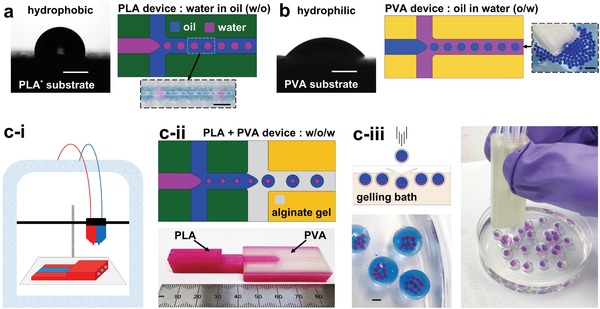Figure 1.

3D‐printing of microfluidic devices in hydrophobic and hydrophilic polymers enables the production of both water droplets in oil and oil droplets in water. Dual‐material printed microfluidic devices allow the sequential application of these droplet formation regimes to produce triple emulsions of hierarchical water/oil/water droplet structures. a) 3D‐printed polylactic acid (PLA) substrate displays hydrophobic properties demonstrated by water contact angle measurement. 3D‐printed PLA T‐junction generates water droplets in oil (schematic and experimental image). b) 3D‐printed polyvinyl alcohol (PVA) substrate demonstrates more hydrophilic properties by water contact angle measurement. 3D‐printed PVA T‐junction generates oil droplets in water (schematic and experimental image of oil (blue) droplet ejection from PVA device into a water bath). c‐i) Dual head extrusion printer enables fabrication of integrated PLA and PVA, dual material, microfluidic devices. c‐ii) (Top) Schematic depiction of operational concept; sequential, droplet generating, flow‐focusing junctions in PLA and PVA, enable the formation of double emulsions (water‐in‐oil‐in‐hydrogel (ungelled) (w/o/w)). Monolithic device realized in lower image, comprised of PLA (pink) and PVA (colorless) materials. c‐iii) Triple emulsions formed as hydrogel droplets are ejected from the microfluidic device. The outer, liquid, alginate phase is gelled upon dripping into a CaCl2 containing gelling bath, creating a triple water‐oil‐water emulsion with a gelled outermost shell. These complex emulsions (pink: aqueous internal phase, blue: oil midphase, colorless: outer alginate shell phase) are individually deposited from a dual material, microfluidic device. All scale bars: 1 mm.
